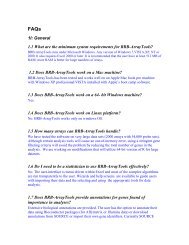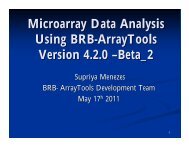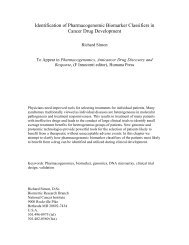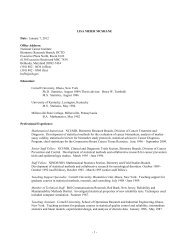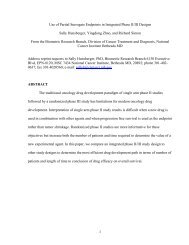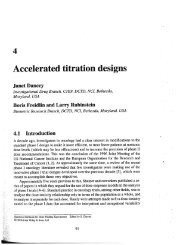A comparison of bootstrap methods and an adjusted bootstrap ...
A comparison of bootstrap methods and an adjusted bootstrap ...
A comparison of bootstrap methods and an adjusted bootstrap ...
You also want an ePaper? Increase the reach of your titles
YUMPU automatically turns print PDFs into web optimized ePapers that Google loves.
n> p situation, the .632+ <strong>bootstrap</strong> is very popular for having low variability <strong><strong>an</strong>d</strong> onlymoderate bias. However, the study in this paper <strong><strong>an</strong>d</strong> the work <strong>of</strong> Molinaro et al. [8]suggest that the .632+ <strong>bootstrap</strong> c<strong>an</strong> run into problems in the n< p situation. Wepropose <strong>an</strong> <strong>adjusted</strong> <strong>bootstrap</strong> method, its perform<strong>an</strong>ce is robust in various situations <strong><strong>an</strong>d</strong>it achieves a good compromise in the bias-vari<strong>an</strong>ce trade<strong>of</strong>f.2. A REVIEW OF METHODS FOR PREDICTION ERROR ESTIMATIONIn microarray class prediction problem, we observe x = ( t , y ) , i = 1,..., n, oni i inindependent subjects wheretiis ap -dimensional vector containing the gene expressionmeasurements <strong><strong>an</strong>d</strong>yiis the response for subject i . The observations x1,..., xnc<strong>an</strong> beviewed as realizations <strong>of</strong> <strong>an</strong> underlying r<strong><strong>an</strong>d</strong>om variable X = ( TY , ) . With dichotomousoutcome, the response variable Y takes 0 or 1 values distinguishing the two classes. Aprediction rule (model) r(· , xlearn ) is developed based on the information in the learningsetlearnx . The true prediction error ( en= E⎡I{ Y ≠r( T, x)}prediction model built on the observed data x ( x x )following the same r<strong><strong>an</strong>d</strong>om mech<strong>an</strong>ism as X .⎣⎤⎦ ) is the probability that the= ,..., 1 nmisclassifies a future itemWhen the prediction rule is built for the observed data, the prediction accuracy shouldideally be assessed on <strong>an</strong> independent large test set. But this <strong>of</strong>ten is impossible because<strong>of</strong> the relatively small sample sizes in microarray experiments. Methods for estimatingprediction errors rely on partitioning or resampling the observed data to construct thelearning <strong><strong>an</strong>d</strong> test sets. With a huge number <strong>of</strong> features, the prediction rules r( ⋅⋅ , ) containtwo key steps: the feature selection <strong><strong>an</strong>d</strong> the class prediction (discrimination) step. Featureselection is administered prior to the class prediction step for every learning set. Failureto include feature selection in resampling steps results in serious downward bias inestimating prediction error <strong><strong>an</strong>d</strong> overly optimistic assessment <strong>of</strong> the prediction rule [10, 11,7]. Methods for class prediction include various versions <strong>of</strong> discrimin<strong>an</strong>t <strong>an</strong>alysis, nearestneighbor classification, classification trees, etc. A comprehensive <strong>comparison</strong> <strong>of</strong> the classdiscrimination <strong>methods</strong> was conducted by Dudoit, Fridly<strong><strong>an</strong>d</strong> <strong><strong>an</strong>d</strong> Speed [12]. In this4



